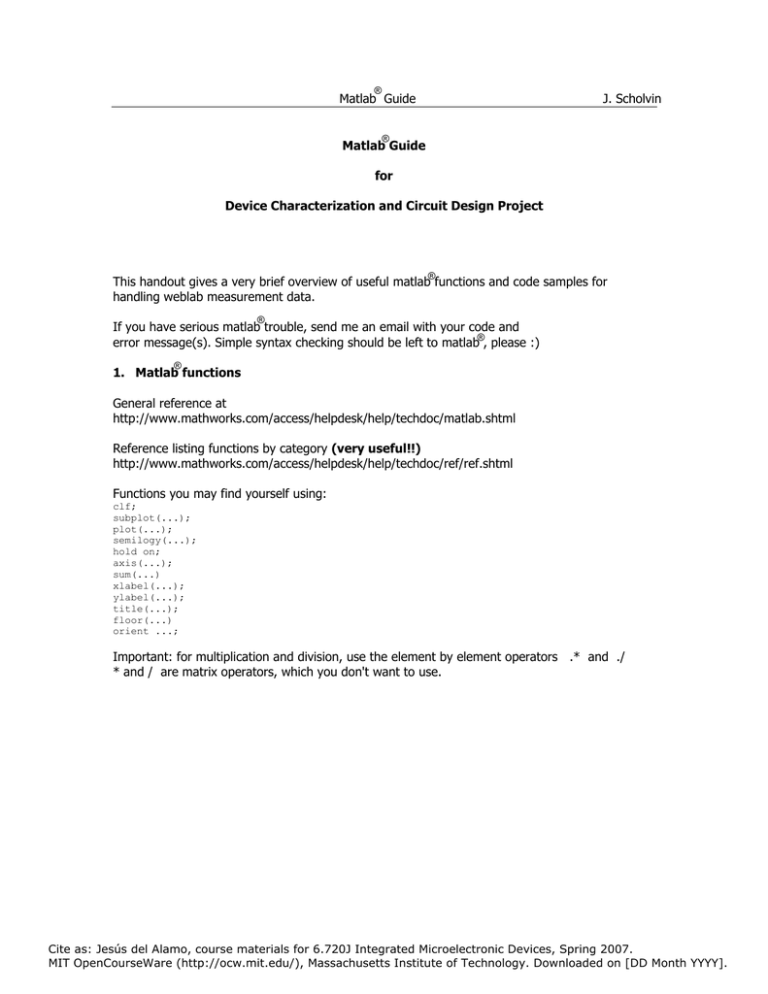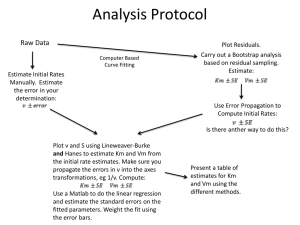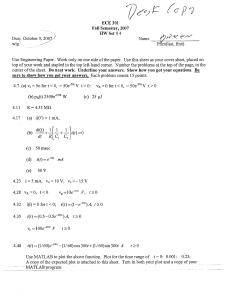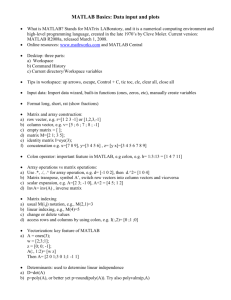Matlab Guide J. Scholvin Matlab Guide
advertisement

®
Matlab Guide
J. Scholvin
®
Matlab Guide
for
Device Characterization and Circuit Design Project
®
This handout gives a very brief overview of useful matlab functions and code samples for
handling weblab measurement data.
®
If you have serious matlab trouble, send me an email with your code and
error message(s). Simple syntax checking should be left to matlab®, please :)
®
1. Matlab functions
General reference at
http://www.mathworks.com/access/helpdesk/help/techdoc/matlab.shtml
Reference listing functions by category (very useful!!)
http://www.mathworks.com/access/helpdesk/help/techdoc/ref/ref.shtml
Functions you may find yourself using:
clf;
subplot(...);
plot(...);
semilogy(...);
hold on;
axis(...);
sum(...)
xlabel(...);
ylabel(...);
title(...);
floor(...)
orient ...;
Important: for multiplication and division, use the element by element operators .* and ./
* and / are matrix operators, which you don't want to use.
Cite as: Jesús del Alamo, course materials for 6.720J Integrated Microelectronic Devices, Spring 2007.
MIT OpenCourseWare (http://ocw.mit.edu/), Massachusetts Institute of Technology. Downloaded on [DD Month YYYY].
2. Code Samples
2.1. Reading the Weblab data file
®
To read directly the CSV file from matlab without having to erase the first 3 lines, create a
function in a file called readWeblabFile.m , with the following content:
% returns a matrix from the weblab data-file <filename>
function [data]=readWeblabFile(filename)
fid=fopen(filename,'r');
data=[];
if (fid==-1)
disp(['ERROR: file not found or could not be opened for read. check file ' filename]);
break;
end
% skip first lines of comments
sLine=fgetl(fid);
sLine=fgetl(fid);
sLine=fgetl(fid);
% read the data
while 1
sLine=fgetl(fid);
if (~ischar(sLine))
% end of file
break;
end
% add line to table
data=[data;str2num(sLine)];
end
fclose(fid);
2.2.
Extracting data
Once you load the data, you must extract the colums that correspond to I, V, etc.
Example: read mos.csv and take the first column to save in variable ID, 2nd column as VG, etc.
For the correct order, look at the comment lines in the csv files.
MOS = readWeblabFile('mos.csv');
ID = MOS(:,1);
VG = MOS(:,2);
VD = MOS(:,3);
...
2.3.
Derivatives
A cheap derivative is to take the difference of two neighboring data points. It won't be very
smooth, but it's sufficient here. You can avoid a for loop if you use the matrix capabilities of
®
matlab. Here we take ro = 1 / [ dID/dVDS ]
roMOS = 1./( ([0;ID]-[ID;0])./([-1;VD]-[VD;-1]) ); roMOS(1)=[];
What is being done? With ([0;ID]-[ID;0]) we shift ID and subtract it. This is ID(n)-ID(n+1) = dID
Similarly, dVDS is computed. The quotient is go, and 1/go = ro. The second line, roMOS(1)=[];
trims the derivative back to the original length, since we inserted an extra row to find the
difference (we said [0;ID] etc). The choice of 0 and -1 in the equation is arbitrary, since the
Cite as: Jesús del Alamo, course materials for 6.720J Integrated Microelectronic Devices, Spring 2007.
MIT OpenCourseWare (http://ocw.mit.edu/), Massachusetts Institute of Technology. Downloaded on [DD Month YYYY].
boundary elements of the derivative are meaningless. The -1 was picked to avoid a divide by
zero error.
Example: for ID=[1,4,9,16,25,36] and VD=[1,2,3,4,5,6] we get
row #
[0;ID]
1
2
3
4
5
6
7
2.4.
[ID;0]
0
1
4
9
16
25
36
1
4
9
16
25
36
0
dI =
[0;ID]-[ID;0]
-1
3
5
7
9
11
13
[-1;VD]
[VD;-1]
-1
1
2
3
4
5
6
1
2
3
4
5
6
-1
dV =
[1;VD]-[VD;1]
-2
1
1
1
1
1
5
roMOS
2
1/3
1/5
1/7
1/9
1/11
-1/13
Plotting data:
Since all the data is in one table, we cannot just plot
plot(VD,ID);
because we would end up with nasty lines drawn through the graph (try it out to see!) Instead
we can split the data up, and plot ID vs VD for every different VG. We can do this automatically:
clf;
% clear graph
vnum=sum([inf;VG]~=[VG;inf])-1; % count the number of VG's we have
vsize=floor(size(VG,1)/vnum);
% for each VG there are this many data points of ID vs VD
% loop through the data, and plot for each VG:
for k=[0:vnum-1]
idx=[(1+k*vsize):(k*vsize+vsize)-1]; % this is where the data is in the big table
subplot(1,2,1);
% 2 graphs on this page
hold on;
% we want to overlap graphs
plot(-VD(idx),-ID(idx));
% I-V characteristics
xlabel('VSD');ylabel('-ID');
% label it
axis tight;
% let's not waste figure space
subplot(1,2,2);
% next plot: ro vs. VSD
hold on;
plot(-VD(idx),roMOS(idx));
% plot ro vs VSD
xlabel('VSD');ylabel('roMOS');
axis([0,3,0,1e5]);
% because the boundaries of the derivative may
% be some oddly large number, fix the axis to only the range of interest.
% add more code here
end
orient tall;
% options for printing: use the whole page available. Looks less shabby!
Repeat this kind of loop for each file that you are processing. If you want to add more graphs,
just add similar code where it says % add more code here
You may want to adjust the subplot
command to accommodate more graphs on one page.
Cite as: Jesús del Alamo, course materials for 6.720J Integrated Microelectronic Devices, Spring 2007.
MIT OpenCourseWare (http://ocw.mit.edu/), Massachusetts Institute of Technology. Downloaded on [DD Month YYYY].
The complete example:
% plot I-V and ro for mosfet measurement
MOS = readWeblabFile('mos.csv');
VG = MOS(:,1);
VD = MOS(:,2);
ID = MOS(:,3);
% take the derivative to get ro
roMOS = 1./( ([0;ID]-[ID;0])./([-1;VD]-[VD;-1]) ); roMOS(1)=[];
clf;
% clear graph
vnum=sum([inf;VG]~=[VG;inf])-1; % count the number of VG's we have
vsize=floor(size(VG,1)/vnum);
% for each VG there are this many data points of ID vs VD
% loop through the data, and plot for each VG:
for k=[0:vnum-1]
idx=[(1+k*vsize):(k*vsize+vsize)-1]; % this is where the data is in the big table
subplot(1,2,1);
% 2 graphs on this page
hold on;
% we want to overlap graphs
plot(-VD(idx),-ID(idx));
% I-V characteristics
xlabel('VSD');ylabel('-ID');
% label it
axis tight;
% let's not waste figure space
subplot(1,2,2); % next plot: ro vs. VSD
hold on;
plot(-VD(idx),roMOS(idx)); % plot ro vs VSD
xlabel('VSD');ylabel('roMOS');
axis([0,3,0,1e5]); % because the boundaries of the derivative may
% be some oddly large number, fix the axis to only the range of interest.
% add more code here
end
orient tall;
% options for printing: use the whole page available. Looks less shabby!
®
MATLAB is a trademark of The MathWorks, Inc.
Cite as: Jesús del Alamo, course materials for 6.720J Integrated Microelectronic Devices, Spring 2007.
MIT OpenCourseWare (http://ocw.mit.edu/), Massachusetts Institute of Technology. Downloaded on [DD Month YYYY].






